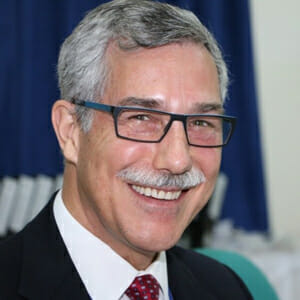
A GUEST ARTICLE FROM J. JOSEPH HOEY
J. Joseph Hoey, Ed.D, is the vice president of accreditation relations and policy with Bridgepoint Education; his portfolio of work includes regional and specialized accreditation and policy related to accreditation. He is co-author with Jill Ferguson and David Chase of the forthcoming volume, Assessment at Creative Institutions: Quantifying and Qualifying the Aesthetic, to be published in 2014 by Common Ground.
In this article, he reviews:
- 6 reasons faculty need to engage in student learning assessment
- 7 steps to take to foster that engagement
- 7 critical questions to ask in framing the conversation around student learning assessment
Developing a program and culture of effective student learning assessment is not sustainable without the support and involvement of the institution’s faculty.
When faculty members are engaged in assessment, it sends a message of active leadership in academic quality to students, parents, legislatures, and external stakeholders.
Faculty engagement in assessment enables innovation in teaching and learning through better understanding of what works and what does not, and serves to forge closer linkages with those who have an interest in hiring our students – employers, agencies, and even the startups that spring from within the engaged institution.
6 Reasons to Get Involved
Here are six reasons why this involvement is both critical and beneficial to academic departments:
PUBLIC EXPECTATIONS & DEPARTMENTAL REPUTATION
Public expectations with regard to the quality of student learning have grown ever larger. The department that positions itself as a leader in evidence-based exploration of teaching and learning is one that is likely to be seen as an exemplar of good practice and achieve both internal and external recognition.
THE IMPACT ON STUDENT SUCCESS & COMPLETION
Departments that pay systematic attention to what, how, where and how well students are learning, and that actively engage in keeping the curriculum current, are far more likely to attract and retain students through to completion. As significant as issues of enrollment, retention and completion are right now, this should be motivation enough for many!
IDENTIFYING MOST EFFECTIVE EMERGING LEARNING TECHNOLOGIES
Information and technology advances are contributing to an intense focus on teaching and learning, especially regarding teaching and learning in online programs. Assessment studies can provide evidence to help faculty understand what is working and what is not working, and to demonstrate the effectiveness of their pedagogy.
SECURING DEPARTMENTAL BUDGETS
Departments that can demonstrate their effectiveness through assessment-based evidence of student learning, and that can do so over time, are far more likely to be able to make their case at the budget table. Conversely, those departments that rely on anecdote will place themselves increasingly at risk. The same applies for additional state-level funding initiatives.
DEEPER ACCESS TO GRANTS AND CONTRACTS
Faculty who can provide tangible evidence of student learning in a systematically designed study will be more likely to succeed in education grants and contracts proposals; providing systematic evidence of the success of a project through achievement of intended learning outcomes will mark principal investigators as leaders deserving of further funding.
THE SHIFTING LANDSCAPE OF TENURE
Promotion and tenure criteria are shifting in colleges and universities across the country. The Scholarship of Teaching and Learning has been legitimated as a valid form of scholarship in the rewards systems of many institutions, and the trend is likely to accelerate.
7 Steps to Take
If you’re interested in engaging more of your faculty colleagues, here’s where to start:
START WITH A SMALL, INTERESTED GROUP
Innovations begin with a core group of interested faculty. Seek out those interested; find early champions, and build a foundation of interest organically. The U.S. Constitution was written by only three people but has had considerable influence over the years.
BASE THE EFFORT IN YOUR VALUES, GOALS, AND MISSION
As we plan for assessment, it’s important to start with the mission, values and core expectations for what students should learn. Who are we as a group of scholars, teachers and innovators and how will our most prized accomplishments, our students, be a reflection of that?
KEEP IT SIMPLE AND GO FOR THE LOW-HANGING FRUIT!
We’ve all got a lot of responsibilities and the initiative has to be sustainable to be successful. Top-heavy structures are more likely to topple over.
START NOW, AND FOLLOW THROUGH
It will not be perfect the first time through and everyone will need to have a voice in how to improve the process. The idea is to begin to build a reflective process of inquiry, grounded in our expectations for what students should learn and supported by factual evidence of their learning.
PROVIDE OVERWHELMING SUPPORT
Provide information and resources on the web, professional development, one-on-one consultation, forums and other opportunities to share progress.
PROVIDE RECOGNITION, REWARDS, AND WAYS OF COMMUNICATING INNOVATIONS
We all want to be recognized by our peers and to feel that we are contributing to the greater good.
PLAN FOR APPROPRIATE, TIMELY COMMUNICATION
Develop a well-designed, multiple stage plan for communication. Like a capital campaign, proper roll-out is critical!
7 Critical Questions to Ask
Here are seven critical questions to ask in framing conversations around teaching, learning, and assessment:
SUPPORT AT THE TOP?
At the level of academic leadership, how are we supporting innovation in teaching and learning in our institution? Is the active promotion of evidence-based innovation in teaching and learning built into the job descriptions of our academic administrators?
RESOURCES PROVIDED?
What consultation, professional development, data collection and analysis, web resources on tools and methods, and discipline-specific resources are available right now for faculty interested in advancing teaching, learning and assessment?
REWARDS AND RECOGNITION?
What internal and external rewards and recognition are available for those who are active innovators? How are we communicating our innovations in teaching and learning, and the results ascertained through assessment?
STRUCTURES?
What institutional structures currently promote or inhibit faculty engagement in assessment?
PROGRAM SELF-STUDIES AND REVIEWS?
How do we recognize and value assessment and learning innovation in cyclical academic program reviews? How about in disciplinary and institutional accreditation self-studies?
FACULTY GOVERNANCE?
What is the role of faculty governance in providing oversight and advancement of teaching, learning, and assessment?
REFORMING PROMOTION AND TENURE?
To what extent is engagement in the scholarship of teaching, learning and assessment in the disciplines recognized in annual evaluation, promotion, and tenure processes?


